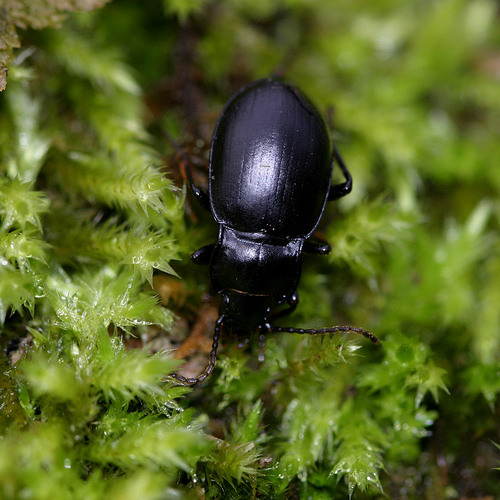Reproduction
While it may seem that this kind of beetle will reproduce like any other arthropod, little is actually known about the reproduction of the bombardier beetle (Erwin 1967). According to the University of Michigan's Zoology Resource (ADW 2012), Metrius contractus reproduces in areas that are highly concentrated in dead matter to serve as a food source. The beetle will lay its eggs in areas that will protect the eggs from predators (ADW 2012). The eggs will then hatch and grow into larvae (ADW 2012). During their development, the larvae will undergo a process that is known as ecdysis (Campbell et al. 2008). This is the process of the larva shedding their chitinous outer layer to allow the organism, in this case the beetle, to grow. Many arthropods complete this shedding process since the tough outer layer cannot grow with the organism (Campbell et al. 2008). Ecdysis is a trait that is found in the phylums Arthropoda and Nematoda (which includes the roundworms). Some examples of other arthropods that
complete ecdysis are The Embossed Snowfly, The Cat Flea, The Elm Sawfly, and The Mother's Day Caddisfly. Metrius contractus will do this molting process many times before it reaches full maturity.
The next stage that the beetle enters is the pupa stage (ADW 2012). The beetle has almost completed its developmental stage! During the pupa stage, the pupa has little hairs covering its back and appears white (Erwin 1967). The hairs are important to help keep the pupa dry since its habitat is typically highly moisturized (Erwin 1967). The body then begins to turn to a yellowish appearance because of changes in its pigments (Erwin 1967). The cuticle then begins to harden, which typically takes several days to complete (Erwin 1967). After more growth, the pupa will shed its skin one last time and then transform into a mature beetle (ADW 2012)!
It is important that the beetle is in close proximity to a moist environment and to areas that have a high density of dead matter (NWF 2013). Decomposing matter/organisms serve as the primary source of nutrition for the beetles, especially during their larval stage, which is a critical part of their development (ADW 2012). An experiment conducted by Juliano (1986) showed just how important food is for Metrius contractus. In this experiment, bombardier beetles were exposed to limited food sources to see if this would affect the reproduction rate (Juliano 1986). Sure enough, the rate of reproduction in the beetle decreased when food sources were very limited or non-existent (Juliano 1986). Metrius contractus has a very short lifespan compared the lifespans of most organisms like us, usually lasting for several weeks (NWF 2013).
Revisit Form and Function or check out some Ingenious Chemistry!

